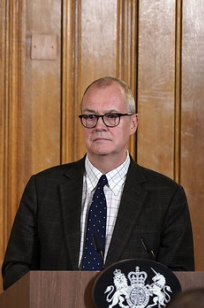Covid-19 update: 2 October
With an increase in local restrictions and university lockdowns, the prime minister Boris Johnson and the government’s chief medical and scientific officers Chris Whitty and Sir Patrick Vallance restarted their public briefings to underline that all the key virus indicators are heading in the wrong direction.
They acknowledged that comparing current positive cases with those identified in March and April was not comparing like with like. At the beginning of April, hospital and community testing was only in the 10,000 – 15,000 per day range compared with the current 210,000.
While current detected infection levels may appear to be exceeding those back in April, Sir Patrick suggested that at the peak of the pandemic, it is likely that more than 100,000 people a day were contracting the virus.
However any comparison needs to allow for the fact that the current testing programme is also not finding all cases – due to asymptomatic infections and problems with access to tests. The Office for National Statistics infection survey pilot estimated there were about 9,600 new cases per day for the week to 19 September. An educated guess (BBC Radio 4’s More or less) puts the current figure at between 15,000-20,000 allowing for the whole of the UK and the fact that cases have been trending up. This is still a long way short of the likely incidence rate in April.
Even with this qualification, the direction of travel appears clear. ‘Numbers of cases are going up, hospitalisations are going up, ICUs are going up and unfortunately, very sadly, so are deaths and that means this is heading in the wrong direction and there is no cause for complacency at all,’ said Sir Patrick (pictured).
Professor Whitty also suggested that there is the possibility that the virus was exhibiting a different pattern this time around, with more concentrated impacts in some areas similar to those experienced in Spain and Italy earlier in the year. The higher increases in cases and test positivity percentages in the North East, North West, Yorkshire and Humber and the West Midlands were a cause for concern.
Rising admissions
Hospitalisations provide a more robust indicator of the strength of the outbreak, as they are not dependent on the level of testing. And here too there are increases. Of particular concern is the rising admission rate among people over 75 – a clear indicator that the virus is spreading across the whole population not just among the more socially active younger generation.
This trend can also be seen in the admission rates for intensive care units, which again are most alarming in the north of England, although London has also seen a rapid rise. Daily deaths – which can lag hospitalisations by a number of weeks – are now at the same level (71 on the last day of September) as when the country first went into national lockdown in March.
Adding to the barrage of statistics being thrown at the public, the Department of Health and Social Care released interim findings of the Real-time Assessment of Community Transmission (REACT) programme’s second study of the virus’s prevalence in the population as a whole. This work – undertaken by Imperial College London and Ipsos MORI – suggests one in 200 people had the virus between 18 and 26 September, but also suggest the growth of infection may be slowing.
Infection was highest in those aged 18-24 – with one in 100 people infected. Compared with the last report, prevalence in the 65+ age group had increased seven-fold. In better news, the study suggested the R rate may have reduced from 1.7 to 1.1, although it warned there is considerable uncertainty around this apparent deceleration.
The clear message is that the country is now facing a second wave of the virus and local lockdowns are attempting to bear down on major hotspots, particularly in the north of England. The prime minister and his advisers repeatedly stressed the importance of everyone following national and local rules to limit social contacts.
This message was undermined by the news that Scottish National Party MP Margaret Ferrier travelled from Scotland to London despite having just been tested for coronavirus because she had been displaying ‘mild symptoms’. Having spoken in a Commons debate, she then discovered her test was positive but still decided to travel back to Scotland by train. The story was only overshadowed on Friday morning by the news that US president Donald Trump had tested positive for the virus and was now self-isolating along with the first lady Melania Trump.
Preparing for a second wave
Back in the UK, attention is now firmly on learning lessons from the first wave and ensuring the NHS is as prepared as possible to manage with any further increase in hospitalisations, while continuing to deliver as full a range of non-Covid services as possible
Personal protective equipment (PPE) was a very visible problem first time around, with this week’s report from the Commons Health and Social Care Committee – Delivering core NHS and care services during the pandemic and beyond – reminding everyone of the ‘persistent failures’ with procurement and supply of gowns, masks and other protective clothing.
But publishing a new PPE strategy this week, the Department said that it now had an uninterrupted supply to meet the challenges in the coming months. With over 32 billion items now purchased, there are four-month stockpiles of key items. And by December, 70% of the demand will be met by UK manufacturers – before the pandemic, just 1% of PPE was produced in the UK.
With 58,000 different settings now being supplied, Lord Paul Deighton, adviser to the health secretary on PPE, said the distribution network had been overhauled to ‘ensure there is a reliable supply over the years to come’. ‘The PPE strategy outlines how we are building further resilience in order to be ready for a new wave of infections in the autumn, winter or beyond,’ he added.
If PPE is in the right place ahead of possible increased demand in the NHS, so are stocks of ventilators. Very early estimates suggested the NHS might need 10 times as many mechanical ventilators as the 9,000 it had access to at the start of the pandemic, although these estimates were quickly scaled back as the outbreak progressed.
The government set about increasing ventilator capacity, both buying from existing suppliers (led by DHSC) and encouraging UK manufacturers to scale up production in a ventilator challenge (led by the Cabinet Office). A report from the National Audit Office this week concluded that both parts of the programme basically worked well.
The programmes prioritised speed over cost and while that cost (£569m) was higher than the NAO or the departments would have expected in ‘normal’ times, the programmes maintained a good audit trail and were managed effectively. While the programmes missed milestones along the way, the new ventilators were not needed at the April peak. In fact, the number of ventilators in the NHS always exceeded demand and the ultimate target of 30,000 machines was reached in August. This leaves the NHS ‘much better prepared for what happens next’, according to Public Accounts Committee chair Meg Hillier – see Ventilator stockpile means NHS is well prepared.
Call to expand testing
One of the key areas still needing further attention is the testing and contact tracing service. There remain major problems with demand outstripping current capacity. Even so, the Commons Health and Social Care Committee wants to see the programme expanded to enable NHS staff to be tested once a week as soon as possible – see MPs call for routine Covid testing for frontline staff.
‘Weekly testing of NHS staff has been repeatedly promised in hotspot areas – but is still not being delivered,’ said committee chair Jeremy Hunt (pictured). ‘Failure to do so creates a real risk that the NHS will be forced to retreat into being a largely Covid-only service during a second spike.’
The weekly report from the Department about the NHS Test and Trace programme continues to show a service struggling, admittedly in the face of a rising workload. Some 31,373 people tested positive in the week to 23 September – a 61% increase on the previous week and 29,037 of these were transferred to the contact tracing system. Of these, just 71% were reached and asked to provide details of contacts – down from 81% the week before. And this led to the identification of 87,587 contacts – with 72% of these reached and asked to self-isolate.
NHS Providers deputy chief executive Saffron Cordery said the reduction in the number of positive-tested people being contacted was troubling and pointed out that the SAGE target of reaching 80% of close contacts was still being missed. ‘While Test and Trace has been built from scratch at great speed, it is becoming increasingly urgent that it does the job we need it to do as we approach winter,’ she said.
The representative body this week published 12 tests that the system must meet to be fit for purpose as demand increases. These include: quadrupling testing capacity in three months (to one million tests a day by the end of December); dramatically improving test turnaround times; a clear plan on who will be eligible for a test as capacity grows; and improving performance at every stage of the contact tracing process.
Ms Cordery also called for the government to be ‘open and honest’ when NHS Test and Trace encounters operational issues. ‘The public needs to know details where there is a problem, the reasons for it, and what is being done to rectify the situation. Without this, public confidence in Test and Trace will unravel and we will all suffer as a result.’
‘Honesty and realism’ were also what the NHS Confederation wanted from political leaders in relation to waiting times and other areas of treatment as the NHS continues to resume services while managing the ongoing threat of coronavirus. Its report this week NHS reset: a new direction for health and care suggested the NHS faced a triple whammy of rising infections, a major backlog of treatment and reduced capacity due to infection control measures.
New settlement
Echoing the HFMA’s recent call for a new long-term settlement from the comprehensive spending review , the confederation said 2018’s five year settlement for the NHS would have to be reassessed. ‘It is clear that additional revenue and capital funding will be needed to cover the additional costs of rising demand, while also enabling the NHS to play catch up with the backlog of treatment,’ the report said. It added that a likely 20% surge in mental health service demand would also need extra resources. And social care also needed its own long-term deal.
Confederation chief executive Danny Mortimer (pictured) said the road to recovery would be long. Despite ‘dire predictions’, the NHS had managed a huge wave of Covid-19 patients while continuing to treat millions not infected with the virus. ‘We have learned much and are in a better position to manage the virus than first time round…but we must take this opportunity to re-cast services for the long-term benefit of patients and local communities,’ he added.
Back at the government press briefing Professor Whitty was also keen to underline the NHS was about far more than Covid care. He said medical colleagues had asked him to stress that the ‘NHS is absolutely open for business’ and that this extended beyond emergencies to cancer care and all other kinds of care. Mr Johnson said this access became ‘much less possible if we get an increased spike in the disease across the country’.
However NHS Providers’ chief executive Chris Hopson was quick to jump on this qualification insisting the NHS had demonstrated that it was able to run Covid and non-Covid services in parallel – there were two non-Covid patients being treated in hospital during the first phase of the virus for every one Covid patient, he said.
While he supported the prime minister’s appeal for people to act responsibly and follow the restrictions, it was vital for people to know that the NHS is open for business ‘whatever the pressures’.
Related content
We are excited to bring you a fun packed Eastern Branch Conference in 2025 over three days.
This event is for those that will benefit from an overview of costing in the NHS or those new to costing and will cover why we cost and the processes.